Friday night, I harvested the components from this board using the heat gun.
Time spent
- straightening leads with a chisel: 10 minutes
- heating and pulling components: 15 minutes
- sorting and putting away components: half an hour
And the sorting time would have been spent anyway if I’d bought the parts in a grab bag.
The take:
- several nice terminal strips, connectors, and a fuse holder
- a handful each of electrolytic and non-electrolytic capacitors
- a handful of resistors
- a handful of diodes, including two Zeners and some 1N4007 rectifiers
- miscellaneous transistors
- miscellaneous ICs, including a speakerphone IC (ah! so this was a dead board from a campus emergency call system), tone generator and detector, low-power audio amplifier, and serial EEPROM
- the inevitable transformer
Not bad, to my way of thinking, for an hour’s free entertainment.
Sorting and Storing
After salvage comes sorting and storing, which are mostly common sense. Here are some things I’ve found to minimize the tedium of sorting and to optimize storage.
My basic principle of sorting is to do so hierarchically. So I first group simmilar components, as shown above. Some components, like connectors and digital logic chips, go straight into bins without further sorting by type or value.
Resistors and capacitors I sort by decade (multiple of 10) immediately and by specific value later.
If I find a batch of several identical capacitors, I like to keep them together in a small bag. If I’m working on a project and want identical caps for aesthetic or technical reasons, it’s easier to grab a bag than to pick through loose caps in a drawer.
Then the capacitors (and bags) go into drawers labeled (approximately) by decade — electrolytics above, others below. Common values of physically larger caps may get split up into their own drawers.
It’s easy to pick out 10X-valued resistors while sorting by decade, so I do that up front (the upper row — 10Ω, 100Ω, 1KΩ, 10KΩ, and 100KΩ). The mixed resistors (lower row) go into a decade drawer
and get put into a row in the parts cabinet for now.
Then sometime later, I’ll go through the decade drawers and sort by individual value.
I’ve seen university EE stockrooms with enough parts bins to have every resistor value in a separate drawer, but most of us don’t have that much money or room for storage. I suggest going to hobby/craft stores and looking for storage solutions designed for beads or for embroidery floss. Bead storage in particular is good about sealing each compartment when the lid is closed, to keep beads resistors from migrating about when the storage is moved or shaken.
I spent several evenings driving all around Wichita a few years ago and came up with these trays, I think for floss, which are perfect for salvaged resistors. (New resistors may need the leads bent a bit to fit in the drawers.) I bought a tray for each decade and have a stack of them sitting beside my workbench.
Most of the resistors I salvage are 5%, which has 24 standard values per decade. I made a spreadsheet of all such values to fit on adhesive return address labels, Avery number 5267, and stuck a label into each spot in the tray. I’d offer the spreadsheet for download, but for some reason I can’t find it any more. ![]()
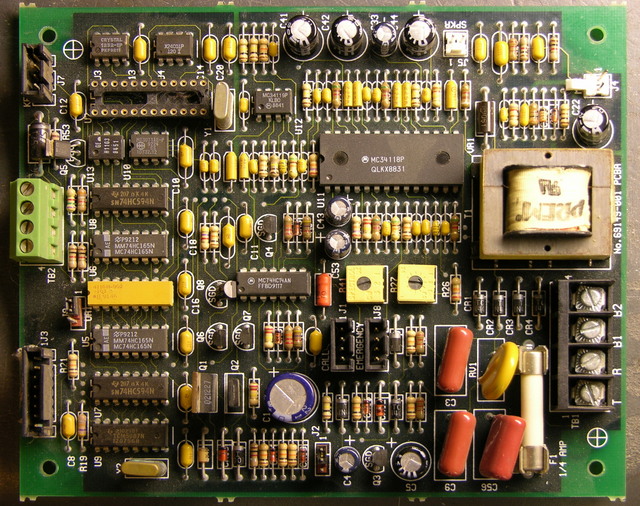
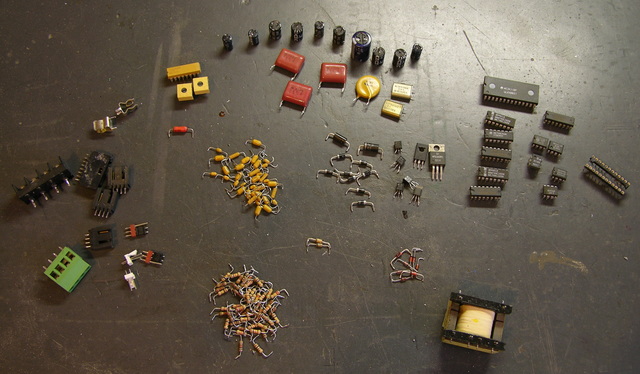
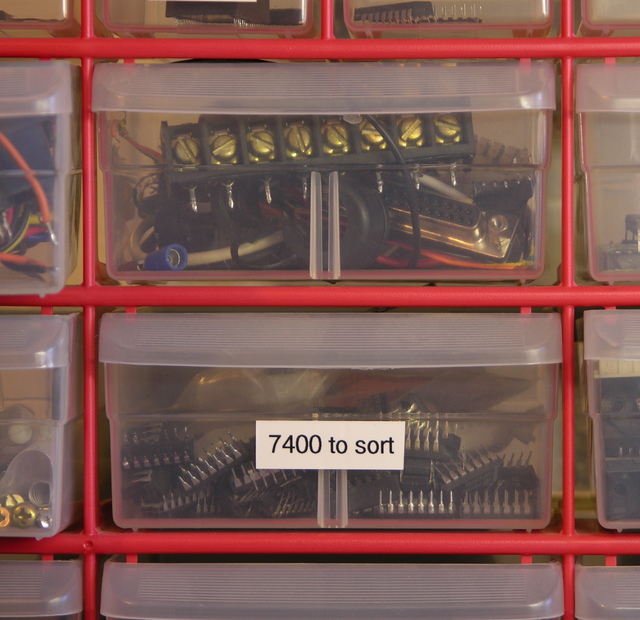
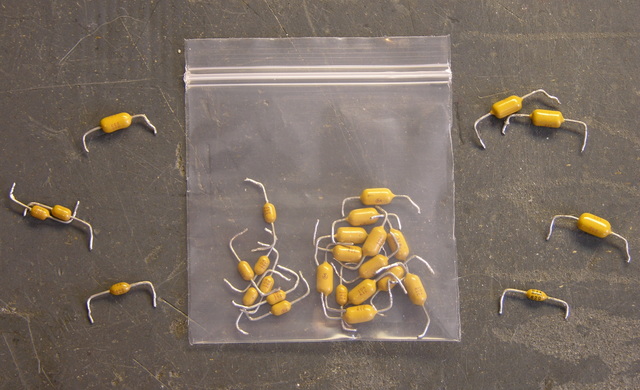

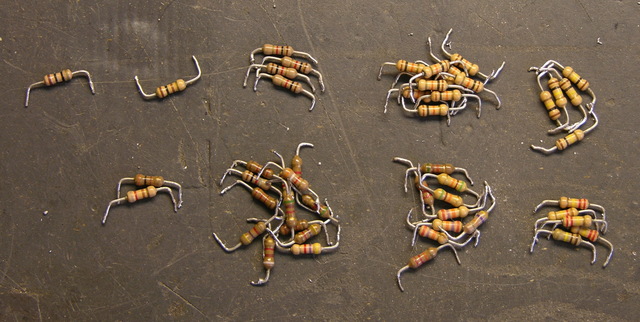
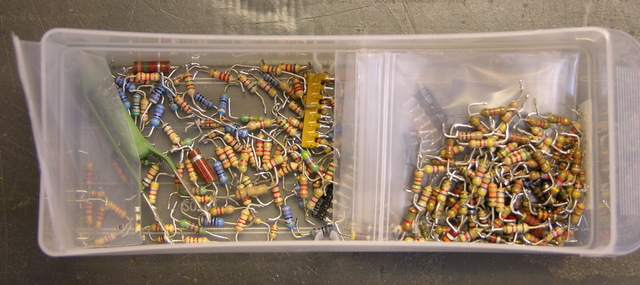

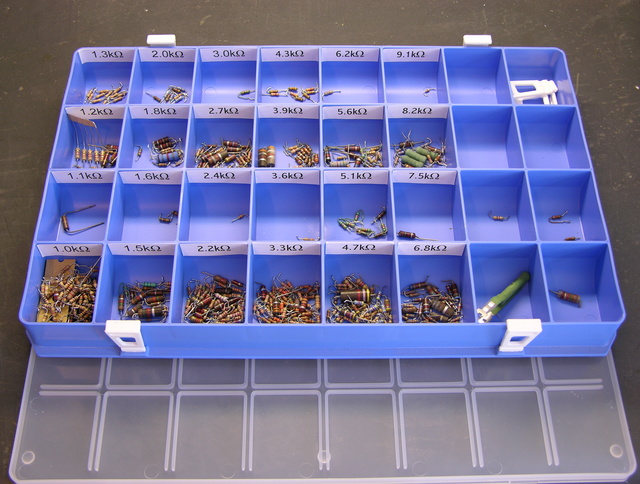
As a beginning electronics-hobbyist I really like your practical, nicely illustrated posts. Keep up the good work,
M
For other storage ideas you might like this instructable:
http://www.instructables.com/id/Ultimate-Parts-Storage/
Or you might try my approach which is to get sick of it half way though, and dump them in a random container to sort “later”.
jak
Josh, I saw that instructable, and it sounded brilliant until I tried it. Let’s just say it doesn’t work for me.
Regarding getting sick of it halfway through — that’s exactly why I sort hierarchically. Every stage of sorting refines the condition of the entire batch; so whenever I quit, I don’t have any piles of total chaos left. There may be more to do later, but it’s further refinement. It makes it feel much more manageable.
I posted an article about scrounging with a heat gun some time back that might be interesting here.
http://www.uchobby.com/index.php/scrounging/how-to-heat-gun/
I also did an article about sorting grabbags that coudl be interesting.
http://www.uchobby.com/index.php/2007/08/09/grab-bag-sorting-how-to/
I store my components in a set of wall cabnets which must be nearly identical you yours. I also keep my components in both by decade and by value. I ususay put three values of 5% resistors per small bin.
For surface mount, I use stackable storage trays and keep each value in a seperate bin.
Regarding resistors, sooner or later you *will* get an assortment pack and stop pulling them
For ICs, there is a nice tool which is essentially a u-bent strip of spring steel with two claws to reach under an IC body. You can usually muster enough force and leverage with these to save yourself the uncrimping work.
Oh, and dremelled off PCI card edge connectors are great for SMD tinkering, manhattan style. They have a convenient 1/20″ spacing
IC and rare transistor storage? Get mail sorting drawers and put a sheet of antistatic foam in.
And sometimes, you just have to make an exc*l sheet of parts….
Faustian — I bought a resistor assortment from Radio Shack when I was about 17. It’s been a long time and I’m pretty sure I’m never going to buy another.
You raise a good point about which tools to use for removing components. I do most things with a textured-jaw needlenose, bigger things with pliers, and DIP ICs with the needlenose (sideways) or the IC puller (like you mention). I haven’t been able to pry out an IC without uncrimping, though, even with the puller.
That’s a great tip about edge connectors! I don’t do Manhattan work, but it’s a brilliant piece of reuse.
radio shack? naaa, ebay industrial surplus lots – ranging from shoebox to pallet size
Great article – especially when you show the “gold mine” of sorted parts. This is what I do too, though I don’t have a good heat gun…have to upgrade. And I like the thought of the $3 chisel – I’ll be picking one up this weekend at my local “Ocean State Job Lot”.
James — you don’t need a good heat gun. In fact, I wouldn’t want to waste a good heat gun running it as long and as often as it takes for salvaging components. I have a $14 Harbor Freight special, and I consider it a consumable item — I’ll replace it as often as I need to.
Good luck with that $3 chisel!
Very nice, a topic dear to my heart. I have added to the links at: http://www.opencircuits.com/Free_From_Salvage and also see: http://www.opencircuits.com/Salvage_Ideas . This is a fairly new Wiki, we are looking for other contributers, perhaps those who have something to say but would do not want a whole website. If they have a website, they may want to use this for links into it.
Not my web site, but one I contribute to ( http://www.opencircuits.com ).
Great article Keith!
I (like most of us) have lots of old boards, non working electronic equipment on the rack – waiting for parts to be salvaged. Your article has inspired me to finally get organized instead of wasting hours looking for the elusive component on one of the boards.
Quick question – where did you source the blue & red (wire?) shelving? And the plastic boxes?
Thanks
Mayank
Mayank — the parts bins are Akro-Mils 44-drawer cabinet #10744 and 64-drawer cabinet #10764. I bought the blue one at Wal-Mart (although they no longer carry them) and the red one at Target (who I think still carries it, although I can’t find it in their online store).
For smaller components and those smaller ones that you have multiple and/or many of, you can use index card/recipe boxes with cards and ziplock bags. So say for resistors you could place the value on the tab in whatever order you like. You can even make each side of the card a different value. If you can’t find bags that fit right, you can simply take a sewing machine and stitch the bags to the card, this also helps if you decide to use each side for a different value. Works great for most capacitors, resistors and various smt.
Cheers,
-mpare
Need a source for equipment to salvage? Less than a week ago I put an ad on Craig’s List requesting old and/or broken electronic gear to salvage parts for my new hobby. I immediately received three replies. Two had TVs, which I opted not to pick up since my storage space is limited and I don’t want to be messing with the CRTs. Then there was the third guy, who had a rather large collection of old PCs (one Mac) and printers. I’ve picked up one load already, filling my Trailblazer. I’m taking the monitors to my favorite local PC repair shop for credit towards trade items. They’re good about that. The guy called me from work yesterday and told me his office was upgrading all of their PCs, so he has a bunch of ‘better’ ones he’d like to give me. So, not only do I have a large pile of crap to dismantle now, I may be giving my wife and a few friends some new PCs.
The printers have given me stepper motors and gears, LCDs, as well as little button switches. The PCs are good for connectors and the power supplies are great for AC power plugs and more hookup wire than you will ever need. Lots of other common components in there I can’t wait to breadboard with. There are lots of ICs too, but I’m not sure if I’ll be able to use them if they are too job specific. I’ll have to look up data sheets for them.
I noticed after I made my post to Craig’s List, someone else had done the same thing, only spamming the whole board with his all caps and poor grammar. So I guess it was a good idea. After I finish pulling and sorting parts, I’ll make another post. Also, I’m very interested in recycling the left over cases so hopefully I’m helping in some way in preventing electronic waste from hitting the local dump.
Any way to recycle the left over PCBs? Can it extract the copper and make copper bars? hahah
Jeremy, I put out a box of stripped PCBs on the curb with a “Copper recycling?” sign on them, and the local recycling company did take them. So my guess is you should be able to get them recycled, especially if you separate them from other materials; and if all else fails, you should be able to drop them at a computer recycling center.
I’m really glad I stumbled across your post. I’m trying to save money on components so I can build simple electronics projects. I have a bunch of old electronics laying around waiting to be salvaged. Can I use my soldering iron instead of the heat gun?
Scott, do whatever works for you. I’ve desoldered with a soldering iron before, but it was for me tremendously slow and tedious compared to the heat gun approach.
Either way, I do recommend lifting the crimped leads with a cheap chisel before desoldering. Saves a huge amount of time.